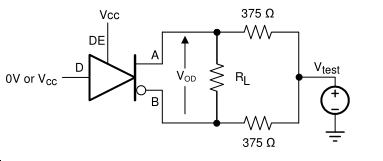Hello,
When a communication failure occurs, I am confused and helpless because I don't understand the specific meaning of the specifications.
There is a sentence in the THVD1550 datasheet: Extended Operational Common-mode: ± 15 V
1)、How should I further understand and experimentally verify it?
2)、Is this parameter the anti-common-mode interference capability of the chip?How does the chip's ability to resist common-mode interference?
3)、Is it the circuit that verifies this parameter?Why connect 375 ohm resistors in series instead of adding 15V common-mode interference directly on the bus?


